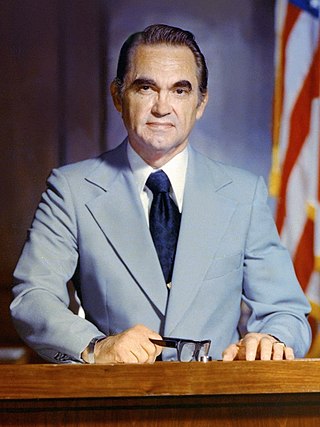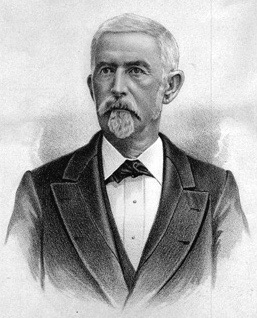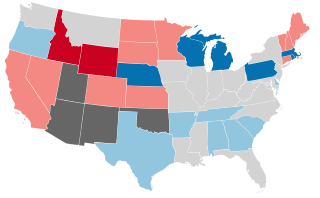For related races, see 1890 United States gubernatorial elections.
| |||||||||||||||||
| |||||||||||||||||
| |||||||||||||||||
The 1890 Alabama gubernatorial election took place on August 4, 1890, in order to elect the governor of Alabama.
| |||||||||||||||||
| |||||||||||||||||
| |||||||||||||||||
| Elections in Alabama |
|---|
 |
The 1890 Alabama gubernatorial election took place on August 4, 1890, in order to elect the governor of Alabama.
| Party | Candidate | Votes | % | |
|---|---|---|---|---|
| Democratic | Thomas G. Jones | 139,912 | 76.12 | |
| Republican | Benjamin M. Long | 42,391 | 23.06 | |
| Prohibition | L. C. Coulson | 1,385 | 0.75 | |
| Other | Write-ins | 109 | 0.06 | |
| Total votes | 183,797 | 100.00 | ||
| Democratic hold | ||||

George Corley Wallace Jr. was an American politician who served as the 45th governor of Alabama for four terms. He is notoriously remembered for his staunch segregationist and populist views. Wallace was a lifelong member of the Democratic Party, and in 1968 a member of the American Independent Party, after a political realignment within the Democratic party shifted in favor of the Civil rights movement. During Wallace's tenure as Governor of Alabama, he promoted "industrial development, low taxes, and trade schools." Wallace sought the United States presidency as a Democrat three times, and once as an American Independent Party candidate, unsuccessfully each time. Wallace opposed desegregation and supported the policies of "Jim Crow" during the Civil Rights Movement, declaring in his 1963 inaugural address that he stood for "segregation now, segregation tomorrow, segregation forever."

The Solid South or the Southern bloc was the electoral voting bloc of the states of the Southern United States for issues that were regarded as particularly important to the interests of Democrats in those states. The Southern bloc existed between the end of the Reconstruction era in 1877 and the passage of the Civil Rights Act of 1964. During this period, the Democratic Party overwhelmingly controlled southern state legislatures, and most local, state and federal officeholders in the South were Democrats. During the late 1800s and early 1900s, Southern Democrats disenfranchised blacks in all Southern states, along with a few non-Southern states doing the same as well. This resulted essentially in a one-party system, in which a candidate's victory in Democratic primary elections was tantamount to election to the office itself. White primaries were another means that the Democrats used to consolidate their political power, excluding blacks from voting in primaries.

Benjamin Meek Miller was an American Democratic politician who served as the 39th Governor of Alabama from 1931 to 1935. The Scottsboro Boys affair notably occurred during his gubernatorial tenure.

Joseph Forney Johnston was an American Democratic politician and businessman who was the 30th governor of Alabama from 1896 to 1900. He later served in the United States Senate from August 6, 1907, to his death on August 8, 1913. As a senator, he was chair of the U.S. Senate Committee to Establish a University of the United States.

Edward Asbury O'Neal was a Confederate officer during the American Civil War and the 26th Governor of Alabama.
Thomas J. Seay was an American Democratic politician who was the 27th Governor of Alabama from 1886 to 1890.

James Milton Smith was a Confederate infantry colonel in the American Civil War, as well as a post-war Governor of Georgia.
The lieutenant governor of Alabama is the president of the Alabama Senate, elected to serve a four-year term. The office was created in 1868, abolished in 1875, and recreated in 1901. According to the current constitution, should the governor be out of the state for more than 20 days, the lieutenant governor becomes acting governor, and if the governor dies, resigns or is removed from office, the lieutenant governor ascends to the governorship. Earlier constitutions said the powers of the governor devolved upon the successor, rather than them necessarily becoming governor, but the official listing includes these as full governors. The governor and lieutenant governor are not elected on the same ticket.

William Columbus Davis was the 11th Lieutenant Governor of Alabama from 1927 to 1931. A Democrat, Davis served Governor Bibb Graves of the same political party.

Kay Ellen Ivey is an American politician who is the 54th governor of Alabama, serving since 2017. Originally a conservative Southern Democrat, Ivey became a member of the Republican Party in 2002. She was the 38th Alabama state treasurer from 2003 to 2011 and the 30th lieutenant governor of Alabama from 2011 to 2017.

The 2010 Alabama gubernatorial election took place on November 2, 2010. Incumbent Republican Governor Bob Riley was term-limited and unable to seek re-election. The party primaries were held on June 1, 2010, with a Republican runoff on July 13. In the general election, Republican Robert J. Bentley defeated Democrat Ron Sparks. This was the first election in which Republicans won three consecutive gubernatorial elections in the state.

The 2018 Alabama gubernatorial election took place on November 6, 2018, to elect the governor of Alabama. Incumbent Republican Governor Kay Ivey, who took office on April 10, 2017, upon the resignation of Governor Robert Bentley, ran for election to a full term and won over Tuscaloosa mayor Walt Maddox. Ivey was sworn into office on January 14, 2019.

The 1892 Alabama gubernatorial election took place on August 1, 1892, in order to elect the governor of Alabama.

The 2022 Alabama gubernatorial election took place on November 8, 2022, to elect the governor of Alabama. Incumbent Governor Kay Ivey took office on April 10, 2017 upon the resignation of fellow Republican Robert J. Bentley and won a full term in 2018. She won her bid for a second full term in a landslide.

United States gubernatorial elections were held in 1890, in 27 states, concurrent with the House and Senate elections, on November 4, 1890.
United States gubernatorial elections were held on Tuesday November 6, in 26 states, concurrent with the House, Senate elections and presidential election, on November 6, 1888.

The 2022 Alabama lieutenant gubernatorial election was held on November 8, 2022, to elect the lieutenant governor of the state of Alabama. The election coincided with various other federal and state elections, including for Governor of Alabama. Primary elections were held on May 24, with runoffs scheduled for June 21 if a candidate failed to receive a majority of the vote.